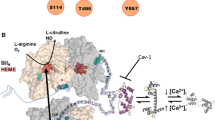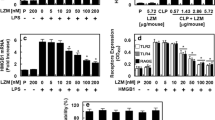Abstract
Background
Nitric oxide (NO), a small effector molecule produced enzymatically from L-arginine by nitric oxide synthase (NOS), is a mediator not only of important homeostatic mechanisms (e.g., blood vessel tone and tissue perfusion), but also of key aspects of local and systemic inflammatory responses. Previous efforts to develop inhibitors of NOS to protect against NO-mediated tissue damage in endotoxin shock have been unsuccessful, largely because such competitive NOS antagonists interfere with critical vasoregulatory NO production in blood vessels and decrease survival in endotoxemic animals. Accordingly, we sought to develop a pharmaceutical approach to selectively inhibit NO production in macrophages while sparing NO responses in blood vessels.
Materials and Methods
The processes of cytokine-inducible L-arginine transport and NO production were studied in the murine macrophage-like cell line (RAW 264.7). A series of multivalent guanylhydrazones were synthesized to inhibit cytokine-inducible L-arginine transport. One such compound (CNI-1493) was studied further in animal models of endothelial-derived relaxing factor (EDRF) activity, carrageenan inflammation, and lethal lipopolysaccharide (LPS) challenge.
Results
Upon activation with cytokines, macrophages increase transport of L-arginine to support the production of NO by NOS. Since endothelial cells do not require this additional arginine transport to produce NO, we reasoned that a competitive inhibitor of cytokine-inducible L-arginine transport would not inhibit EDRF activity in blood vessels, and thus might be effectively employed against endotoxic shock. CNI-1493, a tetravalent guanylhydrazone, proved to be a selective inhibitor of cytokine-inducible arginine transport and NO production, but did not inhibit EDRF activity. In mice, CNI-1493 prevented the development of carrageenan-induced footpad inflammation, and conferred protection against lethal LPS challenge.
Conclusions
A selective inhibitor of cytokine-inducible L-arginine transport that does not inhibit vascular EDRF responses is effective against endotoxin lethality and significantly reduces inflammatory responses.










Similar content being viewed by others
References
Tracey KJ. (1991) Tumor necrosis factor (cachectin) in the biology of septic shock syndrome. Circ. Shock 35: 123–128.
Tracey KJ, Lowry SF. (1990) The role of cytokine mediators in septic shock. Adv. Surg. 23: 21–56.
Bredt DS, Snyder SH. (1994) Nitric oxide: A physiologic messenger molecule. Ann. Rev. Biochem. 63: 175–195.
Geller DA, Nussler AK, DiSilvio M, et al. (1993) Cytokines, endotoxin, and glucocorticoids regulate the expression of inducible nitric oxide synthase in hepatocytes. Proc. Natl. Acad. Sci. U.S.A. 90: 522–526.
Tracey KJ, Vlassara H, Cerami A. (1989) Cachectin/TNF (tumour necrosis factor). Lancet 1: 1122–1126.
Moncada S, Higgs A. (1993) The L-argininenitric oxide pathway. N. Engl. J. Med. 329: 2001–2012.
Nathan C. (1992) Nitric oxide as a secretory product of mammalian cells. F.A.S.E.B. J. 6: 3051–3064.
Weinberg JB, Granger DL, Pisetsky DS, et al. (1994) The role of nitric oxide in the pathogenesis of spontaneous murine autoimmune disease: Increased nitric oxide production and nitric oxide synthase expression in MRL-lpr/lpr mice, and reduction of spontaneous glomerulonephritis and arthritis by orally administered NG-monomethyl-L-arginine. J. Exp. Med. 179: 651–660.
McCartney-Francis N, Allen JB, Mizel DE, et al. (1993) Suppression of arthritis by an inhibitor of nitric oxide synthase. J. Exp. Med. 178: 749–754.
Billiar TR, Curran RD, Harbrecht BG, Steuhr DJ, Demetris AJ, Simmons RL. (1990) Modulation of nitrogen oxide synthesis in vivo: NG monomethyl-L-arginine inhibits endotoxin-induced nitrite/nitrate biosynthesis while promoting hepatic damage. J. Leukocyte Biol. 48: 565–569.
Shultz PJ, Baij L. (1992) Endogenously synthesized nitric oxide prevents endotoxin-induced glomerular thrombosis. J. Clin. Invest. 90: 1718–1725.
Nava E, Palmer RMJ, Moncada S. (1991) Inhibition of nitric oxide synthesis in septic shock: how much is beneficial? Lancet 338: 1555–1557.
Cobb JP, Natanson C, Hoffman WD, et al. (1992) NG-amino-L-arginine, an inhibitor of nitric oxide synthase, raises vascular resistance but increases mortality rates in awake canines challenged with endotoxin. J. Exp. Med. 176: 1175–1182.
Minnard EA, Shou J, Naama H, Cech A, Gallagher H, Daly JM. (1994) Inhibition of nitric oxide synthesis is detrimental during endotoxemia. Arch. Surg. 129: 142–148.
Statman R, Cheng W, Cunningham JN, et al. (1994) Nitric oxide inhibition in the treatment of the sepsis syndrome is detrimental to tissue oxygenation. J. Surg. Res. 57: 93–98.
Ulrich P, Cerami A. (1984) Trypanocidal 1,3-arylene dike tone bis (guanylhydrazone)s. Structure-activity relationships among substituted and heterocyclic analogues. J. Med. Chem. 27: 35–40.
Vodovotz Y, Kwon NS, Pospischil M, Manning J, Paik J, Nathan C. (1994) Inactivation of nitric oxide synthase after prolonged incubation of mouse macrophage with IFN-gamma and bacterial lipopolysaccharide. J. Immunol. 152: 4110–4118.
Bogle RG, Baydoun AR, Pearson JD, Moncada S, Mann GE. (1992) L-arginine transport is increased in macrophages generating nitric oxide. Biochem. J. 284: 15–18.
Baydoun AR, Bogle RG, Pearson JD, Mann GE. (1993) Arginine uptake and metabolism in cultured murine macrophages. Agents Actions 38: C127–C129.
Bredt DS, Hwang PM, Glatt CE, Lowenstein C, Reed RR, Snyder SH. (1991) Cloned and expressed nitric oxide synthase structurally resembles cytochrome P-450 reductase. Nature 351: 714–718.
Tracey KJ, Beutler B, Lowry SF, et al. (1986) Shock and tissue injury induced by recombinant human cachectin. Science 234: 470–474.
Otterness IV, Moore PF. (1988) Carrageenan foot edema test. Methods Enzymol. 162: 320–327.
Bernhagen J, Calandra T, Mitchell RA, et al. (1993) Macrophage migration inhibitory factor (MIF) is a pituitary-derived cytokine and potentiates lethal endotoxaemia. Nature 365: 756–769.
Ding AH, Nathan CF, Stuehr DJ. (1988) Release of reactive nitrogen intermediates and reactive oxygen intermediates from mouse peritoneal macrophages. J. Immunol. 141: 2407–2412.
Nussler AK, Billiar TR, Liu Z, Morris Jr SM. (1994) Coinduction of nitric oxide synthase and argininosuccinate synthetase in a murine macrophage cell line. J. Biochem. 269: 1257–1261.
Granger DL, Hibbs Jr JB, Perfect JR, Durack DT. (1990) Metabolic fate of L-arginine in relation to microbiostatic capability of murine macrophages. J. Clin. Invest. 85: 264–273.
Hibbs Jr JB, Taintor RR, Vavrin Z. (1987) Macrophage cytotoxicity: Role for L-arginine deiminase and imino nitrogen oxidation to nitrite. Science 235: 473–476.
Granger DL, Taintor RR, Cook JL, Hibbs Jr JB. (1980) Injury of neoplastic cells by murine macrophages leads to inhibition of motochondrial respiration. J. Clin. Invest. 65: 357–370.
Sessa WC, Hecker M, Mitchell JA, Vane JR. (1990) The metabolism of L-arginine and its significance for the biosynthesis of endothelium-derived relaxing factor: L-glutamine inhibits the generation of L-arginine by cultured endothelial cells. Proc. Natl. Acad. Sci. U.S.A. 87: 8607–8611.
Hecker M, Sessa WC, Harris HJ, Anggard EE, Vane JR. (1990) The metabolism of L-arginine and its significance for the biosynthesis of endothelium-derived relaxing factor: Cultured endothelial cells recycle L-citrulline to L-arginine. Proc. Natl. Acad. Sci. U.S.A. 87: 8612–8616.
Nussler A, Billiar T, Liu Z, Morris S. (1994) Coinduction of nitric oxide synthase and argininosuccinate synthetase in a murine macrophage cell line. J. Biol. Chem. 269: 1257–1261.
Baydoun AR, Bogle RG, Pearson JD, Mann GE. (1994) Discrimination between citrulline and arginine transport in activated murine macrophages: Inefficient synthesis of NO from recycling of citrulline to arginine. Br. J. Pharmacol. 112: 487–492.
Hrabak A, Idei M, Temesi A. (1994) Arginine supply for nitric oxide synthesis and arginase is mainly exogenous in elicited murine and rat macrophages. Life Sci. 55: 797–805.
Wu G, Brosnan JT. (1992) Macrophages can convert citrulline into arginine. Biochem. Biophysical. Res. Commun. 281: 45–48.
Sato H, Fujiwara M, Bannai S. (1992) Effect of lipopolysaccharide on transport and metabolism of arginine in mouse peritoneal macrophages. J. Leukocyte Biol. 52: 161–164.
Mills CD, Shearer J, Evans R, Caldwell MD. (1992) Macrophage arginine metabolism and the inhibition of stimulation of cancer. J. Immunol. 149: 2709–2714.
Hasan K, Heesen BJ, Corbett JA, et al. (1993) Inhibition of nitric oxide formation by guanidines. Eur. J. Pharmacol. 249: 101–106.
MacAllister RJ, Whitley GSJ, Vallance P. (1994) Effects of guanidino and uremic compounds on nitric oxide pathways. Kidney Int. 45: 737–742.
Kilbourn RG, Gross SS, Jubran A, et al. (1990) Ng-methyl-L-arginine inhibits tumor necrosis factor-induced hypotension: Implications for the involvement of nitric oxide. Proc. Natl. Acad. Sci. U.S.A. 87: 3629–3632.
Cobb JP, Cunnion RE, Danner RL. (1993) Nitric oxide as a target for therapy in septic shock. Crit. Care Med. 21: 1261–1263.
Closs EI, Lyons CR, Kelly C, Cunningham JM. (1993) Characterization of the third member of the MCAT family of cationic amino acid transporters. J. Biol. Chem. 268: 20796–20800.
Albina JA, Caldwell MD, Henry Jr WL, Mills CD. (1989) Regulation of macrophage functions by L-arginine. J. Exp. Med. 169: 1021–1029.
Tracey KJ. (1992) The acute and chronic pathophysiological effects of TNF: Mediation of septic shock and wasting (cachexia). In: Beutler B (ed). Tumor Necrosis Factors: The Molecules and Their Emerging Role in Medicine. Raven Press, New York, pp. 255–273.
Tracey KJ, Fong Y, Hesse DG, et al. (1987) Anti-cachectin/TNF monoclonal antibodies prevent septic shock during lethal bacteraemia. Nature 330: 662–664.
Ialenti A, Ianaro A, Moncada S, DiRosa M. (1992) Modulation of acute inflammation by endogenous nitric oxide. Eur. J. Pharmacol. 211: 177–182.
Ianaro A, O’Donnell CA, Di Rosa M, Liew FY. (1994) A nitric oxide synthase inhibitor reduces inflammation, down-regulates inflammatory cytokines and enhances interleukin-10 production in carrageenin-induced oedema in nice. Immunology 82: 370–375.
Van Dervort AL, Yan L, Madara PJ, et al. (1994) Nitric oxide regulates endotoxin-in-Contributed by A. Cerami on January 18, 1995. duced TNF-alpha production by human neutrophils. J. Immunol. 152: 4102–4109.
Tracey KJ, Cerami A. (1994) Tumor necrosis factor: A pleiotropic cytokine and therapeutic target. Annu. Rev. Med. 45: 491–503.
Acknowledgments
This work was supported in part by National Institutes of Health Grant R01DK49283 (KT), a Faculty Fellowship Award from the American College of Surgeons (KT), a grant from Cytokine Network Inc., and Institutional Funding from the Picower Institute.
Author information
Authors and Affiliations
Rights and permissions
About this article
Cite this article
Bianchi, M., Ulrich, P., Bloom, O. et al. An Inhibitor of Macrophage Arginine Transport and Nitric Oxide Production (CNI-1493) Prevents Acute Inflammation and Endotoxin Lethality. Mol Med 1, 254–266 (1995). https://doi.org/10.1007/BF03401550
Published:
Issue Date:
DOI: https://doi.org/10.1007/BF03401550




